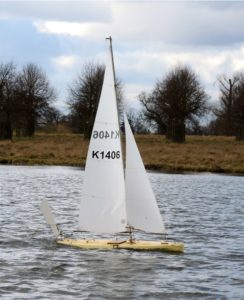Free-Sailed
 A free-sailed boat, whether pursued from a skiff or sailed from side to side of a pond, must be able to maintain a straight course. A variety of mechanisms were used to hold a model on course during a run. The earliest steering gears were weighted, free-swinging rudders; if the boat heeled, the weight swung the rudder to compensate.
A free-sailed boat, whether pursued from a skiff or sailed from side to side of a pond, must be able to maintain a straight course. A variety of mechanisms were used to hold a model on course during a run. The earliest steering gears were weighted, free-swinging rudders; if the boat heeled, the weight swung the rudder to compensate.
Later mechanisms connected the main sheets to the tiller, so that changes in the amount of wind (and therefore the pressure on the sails) caused the tiller to move in compensation. These were relatively crude, until the Braine gear came along.
The vane gear for self-steering was invented by Nathanael Herreshoff in 1875. The idea laid more or less dormant in both model and full-scale practice until the 1930s, when Sam O. Berge of Norway appears to have re-invented the idea and used it to win an International A class championship. The basic principle is even simpler than that of the Braine gear: The vane “reads” the wind direction over the stern of the boat and moves the rudder if the direction changes. The vane is used in all points of sailing, not just running before the wind.
